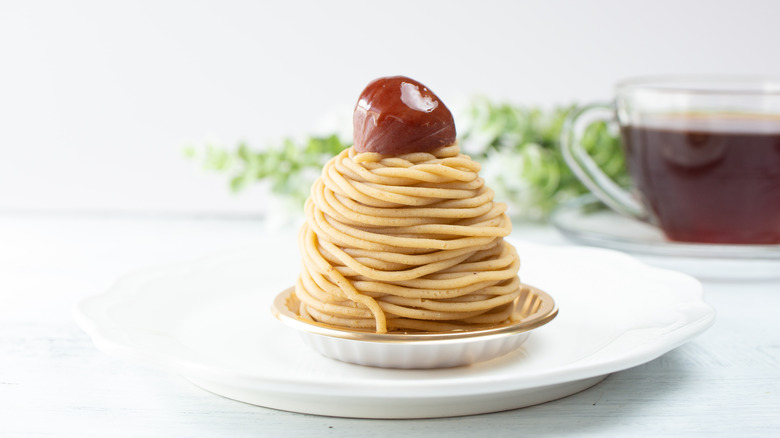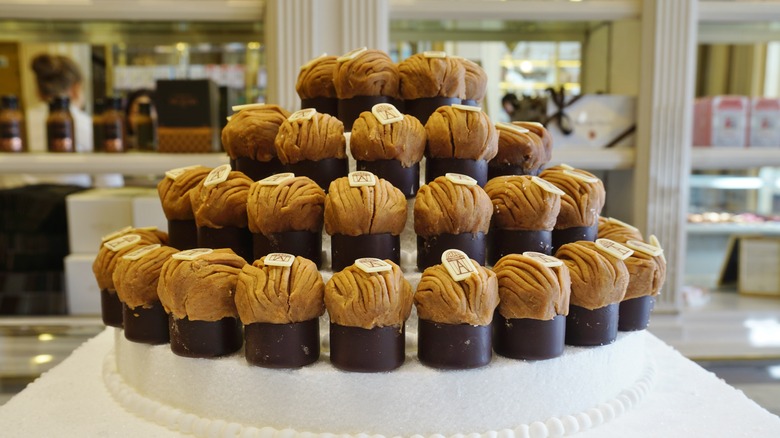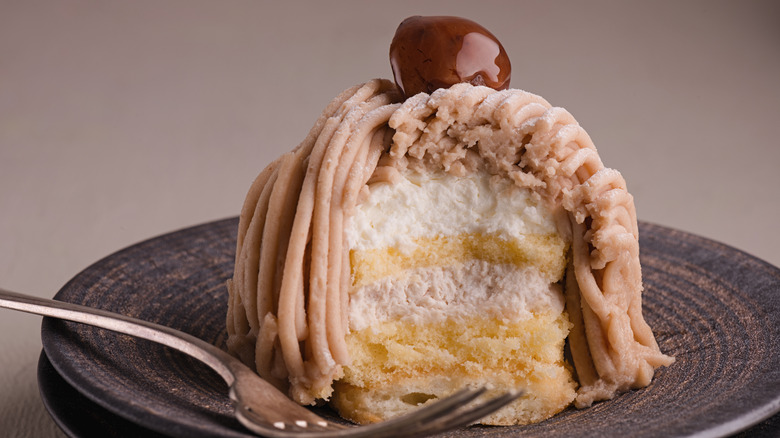Mont Blanc Is A Reason To Eat Pasta For Dessert
It's not pasta, but it sure looks like a tiny pile of it. The Mont Blanc is a showstopping dessert, with its pasta-like twirls made from finely piped ribbons of chestnut puree. Sure, you might have to channel your inner scavenger to track down chestnuts for its unique vermicelli-like topping, but the results are worth the hunt. Slice into a Mont Blanc and you're in for a tasty surprise: a hidden heap of smooth whipped cream, airy meringue, and golden vanilla cake. Each bite brings a delightful blend of textures and flavors, making it a sophisticated treat for any occasion, but especially the holidays. (Chestnuts roasting on an open fire, anyone?)
This dessert is a delightful paradox: sweet and rich in flavor, yet surprisingly light in texture. To add to its seasonal appeal, it resembles a miniature snow-capped mountain sitting right on your plate. In French, the literal translation of Mont Blanc is "white mountain." But beyond its fanciful name, tracing the history of the delicious Mont Blanc leads to some unexpected places.
The cross-continental origin story of Mont Blanc
Despite its French name, the origins of Mont Blanc are sometimes contested. To understand why, you might need to look at a map. Mont Blanc is more than a dessert; it's a real place — the tallest mountain peak in Europe, nestled in the Alps, between France and Italy. Some legends hold that the recipe was first enjoyed in the Middle Ages, while others argue it was invented later in Italy. However, the most substantiated theory traces back to France, where a similar dessert called Compote de Marrons en Vermicelle (French for "chestnut compote in vermicelli") was developed. Anton Rumpelmayer, a pâtissier at the renowned Parisian pastry shop Angelina, is credited with popularizing this recipe, which is still served there today.
No matter where it originated, this chestnutty dessert is enjoyed across Europe and beyond. You'll find it in pastry cases across France, Italy, and Switzerland, but this dessert also has a significant fandom in Asia. Mont Blanc is particularly cherished in Japan, where it was likely popularized by a bakery bearing the same name. Founder Chimao Sakota is said to have introduced the dessert to Japan after a trip to the Alps in the 1930s. Even if you're not planning a trip to Tokyo or Paris, there are still ways you can try a Mont Blanc.
How to try a Mont Blanc for yourself
Your journey to the peak of your very own Mont Blanc (the dessert version) can start right in your neighborhood. Look for it at local pastry shops to see their unique interpretations, which can include everything from a tart shell base to a cocoa-infused exterior. If you're feeling adventurous, making Mont Blanc at home can be quite fulfilling. Its components are mostly straightforward — vanilla cake, meringue, and whipped cream, with the exception being chestnut puree. You can sometimes find whole chestnuts for the puree at your local grocery store or farmer's market during the fall or winter season. Another option is to pick up packaged, precooked chestnuts from stores or online. And for a simpler route, chestnut puree is also available online. (And yes, you could potentially buy ready-made whipped cream, cake, and meringue cookies, too!)
Assembling Mont Blanc is where the fun begins. Start with a base of vanilla cake, add a dome of meringue, and then a mountain of whipped cream. The crowning glory is the chestnut puree, piped on top in a style that can range from elegant coils to a more rustic, shaggy look à la Cousin It from the Addams Family. Each version brings charm to this classic dessert. Whether you make it at home or find it at a bakery, Mont Blanc offers a delightful blend of flavors and textures, making it a perfect choice for holiday celebrations or any time you crave something special.


